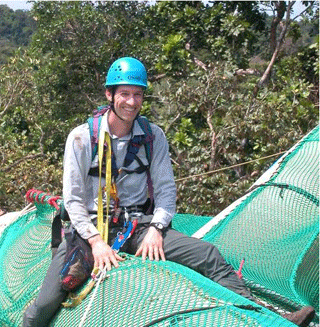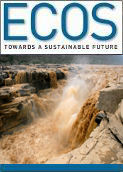
|
Published: 20 December 2012
Treetop science to refine global biodiversity mapping
In a world-first study, a team of 102 international researchers has created a detailed picture of the richness of arthropod diversity in a tropical forest, highlighting the complex co-dependencies between plants and animals.
The study, which made the cover of the prestigious peer-reviewed journal Science, was undertaken in the San Lorenzo forest in Panama and spans almost ten years of field research and subsequent species identification by taxonomic experts across the world.
According to co-author, Professor Raphael Didham of CSIRO Ecosystem Sciences and The University of Western Australia (UWA), the work is important because ‘it is the first time researchers have examined arthropods of all kinds, not just selected groups of insects, and established the strength of their association with plant species diversity.’
Over the course of more than 24,000 person days, researchers combed about half a hectare from forest floor to the top of the tree canopy, observing all microhabitats and plant species.
The 102 researchers spent two years sampling the forest, and eight years sorting through and identifying 130,000 ‘bugs’ or arthropods, representing more than 6000 species. Arthropods represent the largest class in the animal kingdom, and include insects, spiders, crustaceans, millipedes and centipedes.
‘We calculated that around 25,000 species of arthropod live in a 6000 hectare tropical rainforest and that was about 20 times the number of plant species, 83 times the number of bird species and 312 times the number of mammal species,’ said Prof. Didham.
‘At times it was more like the set of an Indiana Jones movie. Together we spent nearly 70 person years atop cranes, balloons and inflatable pontoons in the canopy, dangling off ropes in the forest layers, and sifting through soil and litter while crawling across the forest floor.’
The researchers intensively sampled 12 sites in Panama’s San Lorenzo forest and used their findings to ‘scale-up’ an understanding of rainforest biodiversity across the region.
‘We found that a surprisingly large proportion – about 60 per cent – of all species in the region could be detected within a single hectare of forest, which means it is possible to scale-up results from a relatively small sampling area.
‘Most importantly, we also found that patterns of plant diversity across a region correspond closely with levels of arthropod diversity and can be used to predict it. This adds support to a focus on conserving plant diversity and, along with it, arthropod diversity.
‘We have shown that the broad scientific cooperation through which this study was achieved is an effective way to estimate biodiversity.’
Prof. Didham and his CSIRO colleagues are now exploring new ways of mapping regional biodiversity that are less resource-intensive and time-consuming.
Source: CSIRO & UWA




